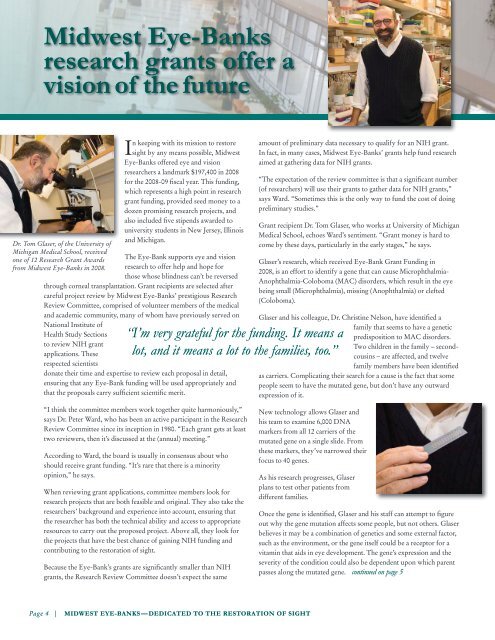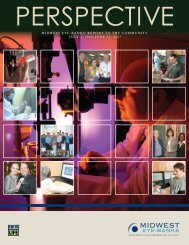Midwest eye-Banks' RepoRt to the CoMMunity July 1, 2007-June 30 ...
Midwest eye-Banks' RepoRt to the CoMMunity July 1, 2007-June 30 ...
Midwest eye-Banks' RepoRt to the CoMMunity July 1, 2007-June 30 ...
You also want an ePaper? Increase the reach of your titles
YUMPU automatically turns print PDFs into web optimized ePapers that Google loves.
<strong>Midwest</strong> Eye-Banks<br />
research grants offer a<br />
vision of <strong>the</strong> future<br />
Dr. Tom Glaser, of <strong>the</strong> University of<br />
Michigan Medical School, received<br />
one of 12 Research Grant Awards<br />
from <strong>Midwest</strong> Eye-Banks in 2008.<br />
in keeping with its mission <strong>to</strong> res<strong>to</strong>re<br />
sight by any means possible, <strong>Midwest</strong><br />
Eye-Banks offered <strong>eye</strong> and vision<br />
researchers a landmark $197,400 in 2008<br />
for <strong>the</strong> 2008-09 fiscal year. This funding,<br />
which represents a high point in research<br />
grant funding, provided seed money <strong>to</strong> a<br />
dozen promising research projects, and<br />
also included five stipends awarded <strong>to</strong><br />
university students in new Jersey, illinois<br />
and Michigan.<br />
The Eye-Bank supports <strong>eye</strong> and vision<br />
research <strong>to</strong> offer help and hope for<br />
those whose blindness can’t be reversed<br />
through corneal transplantation. Grant recipients are selected after<br />
careful project review by <strong>Midwest</strong> Eye-Banks’ prestigious Research<br />
Review Committee, comprised of volunteer members of <strong>the</strong> medical<br />
and academic community, many of whom have previously served on<br />
national institute of<br />
“I’m very grateful for <strong>the</strong> funding. It means a<br />
lot, and it means a lot <strong>to</strong> <strong>the</strong> families, <strong>to</strong>o.”<br />
Health Study Sections<br />
<strong>to</strong> review niH grant<br />
applications. These<br />
respected scientists<br />
donate <strong>the</strong>ir time and expertise <strong>to</strong> review each proposal in detail,<br />
ensuring that any Eye-Bank funding will be used appropriately and<br />
that <strong>the</strong> proposals carry sufficient scientific merit.<br />
“i think <strong>the</strong> committee members work <strong>to</strong>ge<strong>the</strong>r quite harmoniously,”<br />
says Dr. Peter Ward, who has been an active participant in <strong>the</strong> Research<br />
Review Committee since its inception in 1980. “Each grant gets at least<br />
two reviewers, <strong>the</strong>n it’s discussed at <strong>the</strong> (annual) meeting.”<br />
according <strong>to</strong> Ward, <strong>the</strong> board is usually in consensus about who<br />
should receive grant funding. “it’s rare that <strong>the</strong>re is a minority<br />
opinion,” he says.<br />
When reviewing grant applications, committee members look for<br />
research projects that are both feasible and original. They also take <strong>the</strong><br />
researchers’ background and experience in<strong>to</strong> account, ensuring that<br />
<strong>the</strong> researcher has both <strong>the</strong> technical ability and access <strong>to</strong> appropriate<br />
resources <strong>to</strong> carry out <strong>the</strong> proposed project. above all, <strong>the</strong>y look for<br />
<strong>the</strong> projects that have <strong>the</strong> best chance of gaining niH funding and<br />
contributing <strong>to</strong> <strong>the</strong> res<strong>to</strong>ration of sight.<br />
Because <strong>the</strong> Eye-Bank’s grants are significantly smaller than niH<br />
grants, <strong>the</strong> Research Review Committee doesn’t expect <strong>the</strong> same<br />
Page 4 | midwest <strong>eye</strong>-banks — dedicated <strong>to</strong> <strong>the</strong> Res<strong>to</strong>Ration oF sight<br />
amount of preliminary data necessary <strong>to</strong> qualify for an niH grant.<br />
in fact, in many cases, <strong>Midwest</strong> Eye-Banks’ grants help fund research<br />
aimed at ga<strong>the</strong>ring data for niH grants.<br />
“The expectation of <strong>the</strong> review committee is that a significant number<br />
(of researchers) will use <strong>the</strong>ir grants <strong>to</strong> ga<strong>the</strong>r data for niH grants,”<br />
says Ward. “Sometimes this is <strong>the</strong> only way <strong>to</strong> fund <strong>the</strong> cost of doing<br />
preliminary studies.”<br />
Grant recipient Dr. Tom Glaser, who works at University of Michigan<br />
Medical School, echoes Ward’s sentiment. “Grant money is hard <strong>to</strong><br />
come by <strong>the</strong>se days, particularly in <strong>the</strong> early stages,” he says.<br />
Glaser’s research, which received Eye-Bank Grant Funding in<br />
2008, is an effort <strong>to</strong> identify a gene that can cause Microphthalmiaanophthalmia-Coloboma<br />
(MaC) disorders, which result in <strong>the</strong> <strong>eye</strong><br />
being small (Microphthalmia), missing (anophthalmia) or clefted<br />
(Coloboma).<br />
Glaser and his colleague, Dr. Christine nelson, have identified a<br />
family that seems <strong>to</strong> have a genetic<br />
predisposition <strong>to</strong> MaC disorders.<br />
Two children in <strong>the</strong> family – secondcousins<br />
– are affected, and twelve<br />
family members have been identified<br />
as carriers. Complicating <strong>the</strong>ir search for a cause is <strong>the</strong> fact that some<br />
people seem <strong>to</strong> have <strong>the</strong> mutated gene, but don’t have any outward<br />
expression of it.<br />
new technology allows Glaser and<br />
his team <strong>to</strong> examine 6,000 Dna<br />
markers from all 12 carriers of <strong>the</strong><br />
mutated gene on a single slide. From<br />
<strong>the</strong>se markers, <strong>the</strong>y’ve narrowed <strong>the</strong>ir<br />
focus <strong>to</strong> 40 genes.<br />
as his research progresses, Glaser<br />
plans <strong>to</strong> test o<strong>the</strong>r patients from<br />
different families.<br />
Once <strong>the</strong> gene is identified, Glaser and his staff can attempt <strong>to</strong> figure<br />
out why <strong>the</strong> gene mutation affects some people, but not o<strong>the</strong>rs. Glaser<br />
believes it may be a combination of genetics and some external fac<strong>to</strong>r,<br />
such as <strong>the</strong> environment, or <strong>the</strong> gene itself could be a recep<strong>to</strong>r for a<br />
vitamin that aids in <strong>eye</strong> development. The gene’s expression and <strong>the</strong><br />
severity of <strong>the</strong> condition could also be dependent upon which parent<br />
passes along <strong>the</strong> mutated gene. continued on page 5



